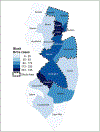The Women's Circle of Health Follow-Up Study: a population-based longitudinal study of Black breast cancer survivors in New Jersey
- PMID: 31907766
- PMCID: PMC7261243
- DOI: 10.1007/s11764-019-00849-8
The Women's Circle of Health Follow-Up Study: a population-based longitudinal study of Black breast cancer survivors in New Jersey
Abstract
Purpose: The Women's Circle of Health Follow-Up Study is an ongoing longitudinal study of African American/Black breast cancer survivors in New Jersey, specifically designed to evaluate the impact of obesity and related comorbidities on breast cancer survival and health-related quality-of-life in this understudied population. Here, we describe our recruitment and data collection methods and compare characteristics of the overall cohort and the subcohort with follow-up data.
Methods: Newly diagnosed breast cancer cases have been recruited into the study since 2006. Pre-diagnosis data on relevant factors and a saliva sample are collected during an in-person interview within 12 months from diagnosis. In 2013, we began active follow up by recontacting participants annually, including two home visits at approximately 2 and 3 years post-diagnosis, during which blood samples are collected. Mortality outcomes (all-cause and breast cancer-specific mortality) are ascertained through linkage with New Jersey State Cancer Registry files. We expect to assemble a cohort of over 2000 Black breast cancer survivors with at least 800 of them having detailed post-diagnosis data.
Results: Distribution of sociodemographic characteristics, body mass index, comorbidities, clinicopathologic characteristics, and treatment modalities were very similar between those in the full cohort and the subset with follow-up data and blood samples. Obesity (> 50%), hypertension (> 58%), and diabetes (22%) were common in this population.
Conclusions and implications for cancer survivors: This ongoing longitudinal study represents a unique resource to better understand breast cancer outcomes, patient-reported symptoms, and health-related quality of life among Black breast cancer survivors.
Keywords: Black women; Breast cancer; Cancer survivors; Comorbidities; Obesity; Quality of life.
Conflict of interest statement
Figures





References
-
- DeSantis CE, Miller KD, Goding Sauer A, Jemal A, Siegel RL. Cancer statistics for African Americans, 2019. CA Cancer J Clin. 2019;69(3):211–33. - PubMed
Publication types
MeSH terms
Grants and funding
LinkOut - more resources
Full Text Sources
Medical

